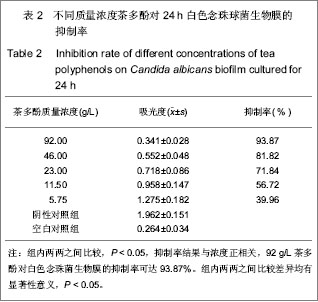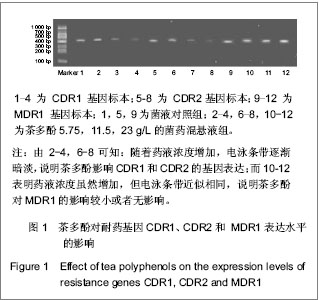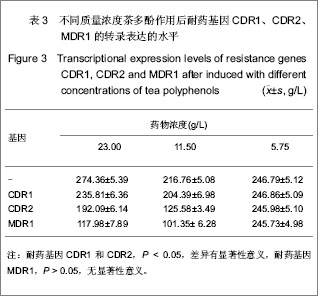| [1] Mah TF,O'Toole GA.Mechanisms of biofilm resistance to antimicrobial agents.Trends Microbiol.2001;9(1):34-39.[2] Chandra J,Kuhn DM,Mukherjee PK,et al.Biofilm formation by the fungal pathogen Candida albicans: development, architecture, and drug resistance.J Bacteriol.2001;183(18): 5385-5394.[3] Sun Z,Liu H. Yi Xue Yan Jiu Za Zhi. 2012;41(6):182-184.孙智,刘泓.新型根管充填材料的回顾研究[J].医学研究杂志, 2012, 41(6):182-184.[4] Liu M,Li Z,Gao WX. Zhong Guo Lao Nian Xue Za Zhi. 2009; 29(9):1144-1145.刘明,李泽,高文信.两种根管充填材料的封闭性能比较[J].中国老年学杂志,2009,29(9):1144-1145.[5] Wang P,Liang HY,Wu J,et al. Zhong Guo Zu Zhi Gong Cheng Yan Jiu Yu Lin Chuang Kang Fu. 2010;14(12):2179-2182.王萍,梁焕友,吴坚,等.两种根管充填材料的封闭性能比较[J].中国组织工程研究与临床康复,2010,14(12):2179-2182. [6] Qin H,Gong YQ,Xu ZH. Zhongguo Zughi Gongcheng Yanjiu Yu Linchuang Kangfu.2011;15(2): 232-235.秦晗,龚永庆,徐宏志.根管充填体外模型构建中X射线牙片的作用[J].中国组织工程研究与临床康复,2011,15(2): 232-235.[7] Gu LS,Ling JQ. Guoji Kouqiang Yixue Zazhi.2006;33(5): 349-351.古丽莎,凌均棨.根管生物膜及其临床控制的研究进展[J].国际口腔医学杂志,2006,33(5):349-351.[8] Qi FF,Wang S,Guo J.Xiandai Kouqiang Yixue Zazhi.2011; 25 (5): 359-362.齐芳芳,王山,郭洁.茶多酚、厚朴酚抑制早期人工根面龋作用的实验研究[J].现代口腔医学杂志,2011,25(5):359-362.[9] Luo YN,Yu XY,Liu LQ.Hua Xue Shi Jie.2011;52(9):526-533.罗亚楠,于晓洋,刘立群.茶叶中茶多酚的提取及分析检测[J].化学世界,2011,52(9):526-533.[10] Liao XL,Lang HY,Xu WF,et al.Fenxi Shiyanshi.2003;22(5): 70-72.廖晓玲,郎惠云,徐文峰,等.钼酸铵分光光度法测定绿茶中的茶多酚[J].分析试验室,2003,22(5):70-72.[11] Tong Z,Dong L,Zhou L,et al.Nisin inhibits dental caries-associated microorganism in vitro.Peptides.2010;31 (11): 2003-2008.[12] 中国知网.中国学术期刊总库[DB/OL].2012-08-10. https://www.cnki.net[13] SCI数据库.Web of Sciencevia ISI Web of Knowledge[DB/OL]. 2012-08-10.http://ip-science.thomsonreuters.com/mjl[14] Soustre J,Rodier MH,Imbert-Bouyer S,et al.Caspofungin modulates in vitro adherence of Candida albicans to plastic coated with extracellular matrix proteins.J Antimicrob Chemother. 2004;53(3):522-525. [15] Bachmann SP,VandeWalle K,Ramage G,et al.In vitro activity of caspofungin against Candida albicans biofilms.Antimicrob Agents Chemother.2002;46(11):3591-3596.[16] Alem MA,Douglas LJ.Effects of aspirin and other nonsteroidal anti-inflammatory drugs on biofilms and planktonic cells of Candida albicans.Antimicrob Agents Chemother.2004; 48(1): 41-47.[17] Chandra J,Kuhn DM,Mukherjee PK,et al.Biofilm formation by the fungal pathogen Candida albicans: development, architecture, and drug resistance.J Bacteriol.2001;183(18): 5385-5394.[18] Hazan Z,Zumeris J,Jacob H,et al.Effective prevention of microbial biofilm formation on medical devices by low-energy surface acoustic waves.Antimicrob Agents Chemother.2006; 50(12):4144-4152.[19] Kuhn DM,Chandra J,Mukherjee PK,et al.Comparison of biofilms formed by Candida albicans and Candida parapsilosis on bioprosthetic surfaces.Infect Immun.2002; 70(2):878-888.[20] Chandra J,Patel JD,Li J,et al.Modification of surface properties of biomaterials influences the ability of Candida albicans to form biofilms.Appl Environ Microbiol.2005; 71(12):8795-8801.[21] Andes D,Nett J,Oschel P,et al.Development and characterization of an in vivo central venous catheter Candida albicans biofilm model.Infect Immun.2004;72(10): 6023-86031.[22] Tsang CS,Ng H,McMillan AS.Antifungal susceptibility of Candida albicans biofilms on titanium discs with different surface roughness.Clin Oral Investig.2007;11(4):361-368.[23] LaFleur MD,Kumamoto CA,Lewis K.Candida albicans biofilms produce antifungal-tolerant persister cells.Antimicrob Agents Chemother.2006;50(11):3839-3846.[24] Szomolay B,Klapper I,Dockery J,et al.Adaptive responses to antimicrobial agents in biofilms.Environ Microbiol.2005;7(8): 1186-1191.[25] Chang GJ,Wang AL.Shan Dong Yi Yao.2007;47(5):81-82.常桂娇,王艾琳.细菌生物膜及其与细菌耐药性关系的研究进展[J].山东医药,2007,47(5):81-82.[26] Alem MA,Oteef MD,Flowers TH,et al.Production of tyrosol by Candida albicans biofilms and its role in quorum sensing and biofilm development.Eukaryot Cell.2006;5(10):1770-1779.[27] Zhang L,Huang YC,Xi TF.Sheng Wu Yi Xue Gong Cheng Yu Lin Chuang.2006;10(3):194-196.张良,黄云超,奚廷斐.表皮葡萄球菌生物膜形成与生物材料感染[J].生物医学工程与临床,2006,10(3):194-196.[28] Thurnheer T,Gmür R,Shapiro S,et al.Mass transport of macromolecules within an in vitro model of supragingival plaque.Appl Environ Microbiol.2003;69(3):1702-1709.[29] Melchior MB,Fink-Gremmels J,Gaastra W.Comparative assessment of the antimicrobial susceptibility of Staphylococcus aureus isolates from bovine mastitis in biofilm versus planktonic culture.J Vet Med B Infect Dis Vet Public Health.2006;53(7):326-332.[30] Baillie GS,Douglas LJ.Iron-limited biofilms of Candida albicans and their susceptibility to amphotericin B.Antimicrob Agents Chemother.1998;42(8):2146-2149.[31] Shi Q,Wang HN,Liu L.Wei Sheng Wu Xue Tong Bao.2008; 35(10):1633-1637.史巧,王红宁,刘立.细菌生物膜与耐药性相关性研究进展[J].微生物学通报.2008;35(10):1633-1637.[32] Borriello G,Werner E,Roe F,et al.Oxygen limitation contributes to antibiotic tolerance of Pseudomonas aeruginosa in biofilms.Antimicrob Agents Chemother.2004;48(7): 2659-2664.[33] Wang YX,Li HL,Li PY.Zhonghua Weishengwuxue He Mianyi Xue Zazhi.2003;23(6):428-431.王勇翔,李华林,李平洋.表皮葡萄球菌生物膜形成与ica操纵子的相关性研究[J].中华微生物学和免疫学杂志,2003,23(6): 428-431.[34] Mukherjee PK,Chandra J,Kuhn DM,et al.Mechanism of fluconazole resistance in Candida albicans biofilms: phase-specific role of efflux pumps and membrane sterols. Infect Immun.2003;71(8):4333-4340.[35] Chen H,Fujita M,Feng Q,et al.Tyrosol is a quorum-sensing molecule in Candida albicans.Proc Natl Acad Sci U S A.2004; 101(14):5048-5052.[36] Kohli A,Smriti,Mukhopadhyay K,et al.In vitro low-level resistance to azoles in Candida albicans is associated with changes in membrane lipid fluidity and asymmetry.Antimicrob Agents Chemother.2002;46(4):1046-1052.[37] Khot PD,Suci PA,Miller RL,et al. small subpopulation of blastospores in candida albicans biofilms exhibit resistance to amphotericin B associated with differential regulation of ergosterol and beta-1,6-glucan pathway genes.Antimicrob Agents Chemother.2006;50(11):3708-3716.[38] Nickerson KW,Atkin AL,Hornby JM. Quorum sensing in dimorphic fungi: farnesol and beyond.Appl Environ Microbiol. 2006;72(6):3805-3813.[39] Xue P,Liu DC.Zhong Guo Yi Yao Dao Bao.2008;5(23):21-22.徐芃,刘东成.临茶多酚抗氧化和抑菌机制的研究[J].中国医药导报,2008,5(23):21-22.[40] Cao YB,Xu Z,Zhang JD,et al.Zhongguo Xinyao Zazhi.2004; 13(2):102-105.曹永兵,徐铮,张军东,等.白色念珠菌耐药性产生的分子机制[J].中国新药杂志,2004,13(2):102-105.[41] Morschhäuser J.The genetic basis of fluconazole resistance development in Candida albicans.Biochim Biophys Acta.2002;1587(2-3):240-248. |



.jpg)
.jpg)